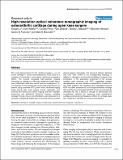High-resolution optical coherence tomographic imaging of osteoarthritic cartilage during open knee surgery
Author(s)
Harman, Michelle; Li, Xingde; Pitris, Costas; Ghanta, Ravi; Fujimoto, James G.; Stamper, Debra L.; Brezinski, Mark E.; Martin, Scott; ... Show more Show less
Downloadar1491.pdf (950.3Kb)
PUBLISHER_CC
Publisher with Creative Commons License
Creative Commons Attribution
Terms of use
Metadata
Show full item recordAbstract
This study demonstrates the first real-time imaging in vivo of human cartilage in normal and osteoarthritic knee joints at a resolution of micrometers, using optical coherence tomography (OCT). This recently developed high-resolution imaging technology is analogous to B-mode ultrasound except that it uses infrared light rather than sound. Real-time imaging with 11-μm resolution at four frames per second was performed on six patients using a portable OCT system with a handheld imaging probe during open knee surgery. Tissue registration was achieved by marking sites before imaging, and then histologic processing was performed. Structural changes including cartilage thinning, fissures, and fibrillations were observed at a resolution substantially higher than is achieved with any current clinical imaging technology. The structural features detected with OCT were evident in the corresponding histology. In addition to changes in architectural morphology, changes in the birefringent or the polarization properties of the articular cartilage were observed with OCT, suggesting collagen disorganization, an early indicator of osteoarthritis. Furthermore, this study supports the hypothesis that polarization-sensitive OCT may allow osteoarthritis to be diagnosed before cartilage thinning. This study illustrates that OCT, which can eventually be developed for use in offices or through an arthroscope, has considerable potential for assessing early osteoarthritic cartilage and monitoring therapeutic effects for cartilage repair with resolution in real time on a scale of micrometers.
Date issued
2005-01Department
Massachusetts Institute of Technology. Department of Electrical Engineering and Computer Science; Massachusetts Institute of Technology. Research Laboratory of ElectronicsJournal
Arthritis Research and Therapy
Publisher
BioMed Central Ltd
Citation
Arthritis Research & Therapy. 2005 Jan 17;7(2):R318-R323
Version: Final published version
ISSN
1478-6362
1478-6354